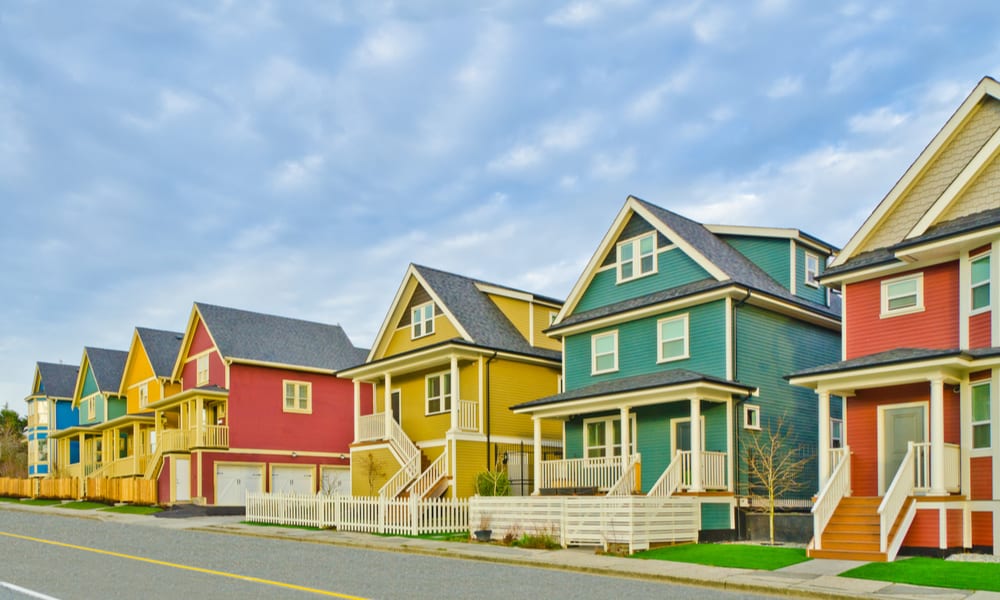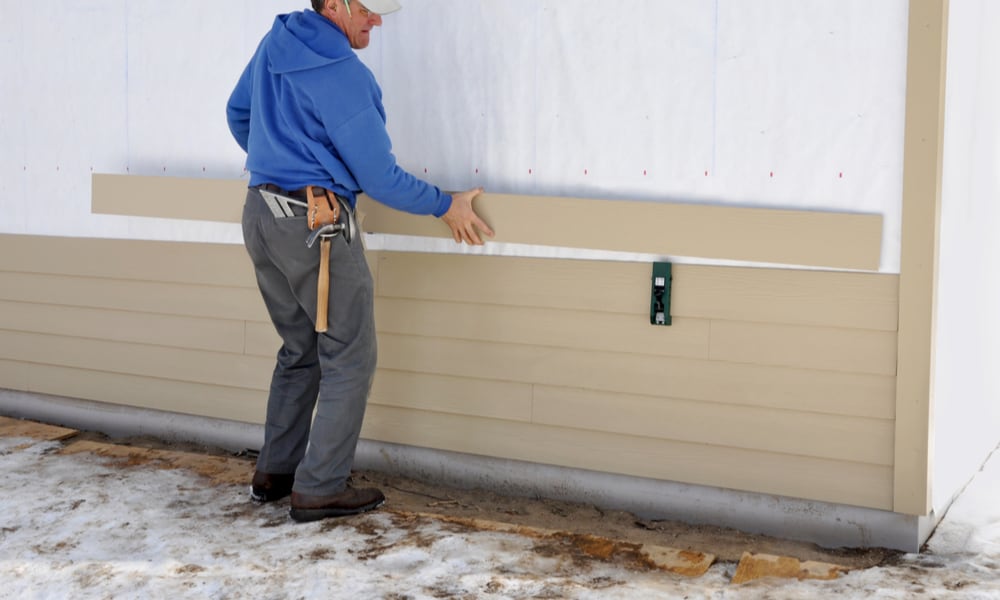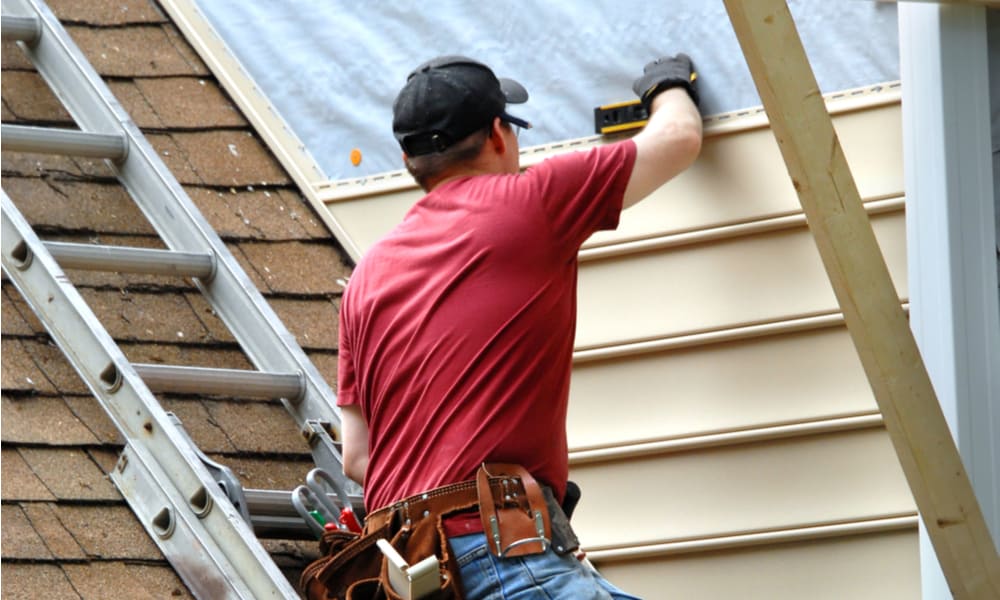When your home’s old siding drags off your property’s curb appeal, you’re faced with two choices: give a new lease of life to the dreary siding with a coat of fresh paint, or replace the offending exterior treatment. But when it comes to painting vinyl siding vs. replacing it, how to know what the best option is?
In short, painting vinyl siding is a great idea if you look for a quick fix and have a low budget. Replacing old siding is more laborious and more expensive, but the new panels will last longer, and you’ll get more for your money.
Table of Contents
Painting Vinyl Siding Pros & Cons
Painting vinyl siding is one of the easiest ways to transform the exterior of your home. The solution is cheap, easy to implement, and appealing to the DIY enthusiasts who don’t quite have the know-how to replace the siding on their own. That doesn’t mean it’s trouble-free. Let’s have a look at this method’s pros and cons.
Advantages
- Affordability: No doubt, the main advantage to painting weathered vinyl siding is the low cost of the project. You can save as much as 50% by painting instead of replacing the old siding.
- Increased curb appeal: If you want to sell your home, a fresh coat of paint can increase your property’s curb appeal without breaking the bank. Considering that money invested in siding are the easiest to recoup, painting the exterior walls before selling could be a great idea.
- More color options: Vinyl siding only comes in so many colors, but paint colors are endless. Most vinyl paints can be mixed and matched, so you can even create a custom shade if you want to.
- Increased siding lifespan: Vinyl is essentially plastic, and although the material is resistant, constant exposure to sunlight and elements will damage it in time. A coat of paint can protect the vinyl siding and increase its lifespan. However, check the manufacturer’s conditions to make sure you can paint the siding without voiding the warranty.
- Time-saving project: Removing and replacing siding from your home requires several days – if not weeks. Painting takes significantly less time and could be more convenient if you need a quick fix.
Drawbacks
- You can’t use any color: Although exterior paints come in a rainbow of colors, you can only make a drastic change if the siding is dark and you wish to paint in a lighter hue. However, if the original color of your vinyl siding is light, painting it in a darker shade isn’t recommended. By absorbing more heat, darker paint can damage the vinyl layer, leading to siding damage and collapse.
- Paint can flake off easily: While exterior paint has a lifespan of around ten years in ideal conditions, paint applied to vinyl siding can peel off easily. Not only should you pay attention to the type of paint, but you must also invest in a paint gun to obtain the best results.
- You will have to clean the walls before painting: As you can expect, paint won’t adhere to a dirty surface. Thus, before embarking on your painting project, you must clean the exterior walls. You can use a pressure washer if you have one, but professional cleaning could drive up the costs of your project.
How Much Does It Cost?
Painting vinyl siding isn’t particularly expensive. On average, the materials will cost you $0.59 per square foot, with a range between $0.41 and $0.78. Thus, if you plan to paint the house yourself, you can expect to pay $295 on average, with a range between $205 and $390 for a 500-square foot surface.
If you want to hire a professional, the costs vary from $1.36 to $2.77 per square foot, including materials and labor. Thus, you could pay between $680 and $1,385 for a 500-square foot surface.
On top of these costs, you should also consider the cost of cleaning. A 3-hour power wash service can cost anywhere between $95 and $231, and you may have to pay more if the cleaners need more than three hours to finish the job.
Replacing Vinyl Siding Pros & Cons
Replacing vinyl siding is more time-consuming and expensive compared to painting, but it could save you money in the long run. Not only will new siding last longer than a coat of paint, but it could also add some R-value to your home.
Advantages
- Higher quality: High-quality vinyl siding provides value year after year and wards off some of the issues painting can’t fix, such as rotting, swelling, or moisture absorption. Insulated vinyl siding can also minimize heat loss in winter, reducing your utility bill costs.
- Little to no maintenance: Although new paint looks great at first, it will require regular maintenance. New vinyl siding only needs periodical cleaning – you won’t have to bother about the colored layer peeling off.
- Variety of choices: Vinyl siding may not come in a bountiful range of colors, but nobody stops you from changing the style. You can pick from traditional clapboard options, Dutch lap siding, beaded seam, scalloped, shake, or even board & batten siding styles. Moreover, you can pick from smooth or wood grain finishes.
- No problems with the warranty: We mentioned that painting your siding could void the warranty. This won’t happen if you replace it altogether.
- Long-term solution: Exterior paint has a lifespan of about ten years in ideal conditions, but new vinyl siding can last for at least 25 years. If maintained correctly, it can last much longer than that. Thus, you’ll get a better return on your investment.
Drawbacks
- Expensive up-front: New siding panels are more expensive than paint, and you’ll most likely have to pay for labor, too. The costs can easily exceed $10,000, depending on the size of your home.
- Short lifespan if installed incorrectly: While you could keep costs low by installing the new siding yourself, incorrectly installed siding is easy to damage. Low-quality siding is also cheaper, but you shouldn’t expect it to last for 25 years.
How Much Does It Cost?
The cost of new vinyl siding varies between $1.98 and $2.74 on a national level, with an average of $2.36 per square foot. So, if you only want to buy the siding and install it yourself, you could pay between $990 and $1,370 for a 500-square foot surface.
However, vinyl siding should be installed professionally if you want it to last. Including labor, the prices vary from $4,65 to $8.37, with an average of $6.51. Thus, the average cost for installing new siding on a 500-square foot home is $3,255.
Considering that the average house in the US has 1,580 square feet of exterior wall areas, you can expect to pay anywhere between $7,347 and $13,225 if you live in an average home.
What to Consider Before Painting or Replacing Vinyl Siding
Painting vinyl siding or replacing it? Here are a few things to consider before deciding:
- Siding age and overall condition: Do you want to paint the siding because you don’t like its original color or to cover small defects? Or do you want to paint it because it’s old and brittle? Newer siding is easier to paint, and it will last longer. However, you can’t expect the paint to extend the lifespan of worn-out siding.
- Siding warranty: If you want to paint new siding simply because you don’t like the color, check the warranty first. Some manufacturers specify that any alterations will void the warranty, meaning that the new coat of paint could leave you unprotected from damage, dents, or improper installation.
- Your budget: How much do you want to spend? If you can’t afford new siding, painting it can increase your property’s curb appeal without breaking the bank.
- Purpose: Why do you want to paint or replace the siding? Are you planning to sell the house or want to refresh the look of your home? If you want to sell, know that a fresh coat of paint can increase its sale value by about 5%. Replacing the siding can also increase the resale value, but you can only expect to recoup about 80% of your investment. However, if you plan to live in the house for the foreseeable future, replacing the siding is well-worth in the long run.
Conclusion
Painting vinyl siding vs. replacing it comes down to your purpose and budget. Both projects will increase the curb appeal of your home. Painting could be a better option if the siding is in relatively good conditions and you plan to sell the house.
You can also choose to paint the siding if you don’t like its color – but pay attention to the warranty terms before you do so.
Replacing old siding is more expensive up-front, but it could save you money in time. New siding will provide better protection from elements, and it can even increase your home’s energy efficiency. Moreover, unpainted vinyl siding is very easy to maintain.
At the end of the day, the choice is yours. What will it be? Tell us in a comment below and share this article with your friends.


